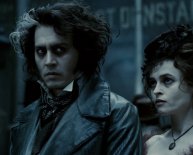
Barber on Fleet Street
 Thanks on skills of Mr. Johnny Depp, many of us are now actually familiar with the storyline of Sweeney Todd, the demon barber of Fleet Street. In 2007 film, Sweeney Todd slashes the throats of their unsuspecting victims and dumps their health into the basement, in which their bones tend to be then removed of their beef and made into pies by Todd’s accomplice, Mrs. Lovett. If you’ve seen this film, you know how the storyline finishes… what-you-may not know, however, is this dark tale isn't the item of Tim Burton’s twisted imagination. It an account which has been around in various types for at the least 150 many years.
Thanks on skills of Mr. Johnny Depp, many of us are now actually familiar with the storyline of Sweeney Todd, the demon barber of Fleet Street. In 2007 film, Sweeney Todd slashes the throats of their unsuspecting victims and dumps their health into the basement, in which their bones tend to be then removed of their beef and made into pies by Todd’s accomplice, Mrs. Lovett. If you’ve seen this film, you know how the storyline finishes… what-you-may not know, however, is this dark tale isn't the item of Tim Burton’s twisted imagination. It an account which has been around in various types for at the least 150 many years.
The story of Sweeney Todd initially appeared in 1846 in subject String of Pearls in a ‘penny dreadful’ (so-named for publication’s cost including its macabre themes). The first version of the story centers upon the disappearance of a sailor called Lietutentant Thornhill, whom comes to London bearing a string of pearls for a woman named Johanna Oakely with respect to the woman missing lover, Mark Ingestrie. After checking out Sweeney Todd’s barber store on Fleet Street, Thornhill vanishes, arousing suspicions amongst their buddies that Todd might have-been mixed up in disappearance of Ingestrie. In a desperate attempt to find the truth about the woman missing lover, Oakely disguises herself as a boy and visits benefit Todd after their former associate, Tobias Ragg, is incarcerated in an insane asylum. In the course of time, Todd’s grisly activities are uncovered whenever Ingestrie, who has been held prisoner beneath the cellars of Mrs. Lovett’s pie shop and forced to are a cook, escapes through raise used to transfer the pies to and through the kitchen. Todd, who's furious at Mrs. Lovett for allowing Ingestrie to escape, after that poisons the girl before he, himself, is hanged for his crimes. Ingestrie and Oakely marry and reside gladly ever before after.
But where performed the concept for this twisted tale originate, and it is truth be told there any truth to it?
The seventeenth, 18th and 19th centuries tend to be rife with rumours in regards to the dubious doings of doctors and cannibalism. On 3 might 1718, The Uk Gazetteer reported:
We've Intelligence from Lincoln, that a guy becoming hanged indeed there [at] the final Assizes, within three days after their execution, a couple of apothecaries contracted with a butcher for an amount of cash, to make the human body out from the grave, and cut off most of the flesh, complement all of them in order to make a skeleton of; which skin he offered for venison to an inn-keeper; whom making it into a pasty, welcomed many of their neighbours towards the eating of it; but sometime following the villainy becoming recognized, the butcher and the two apothecaries had been committed to Lincoln Gaol.
Thankfully, many of these tales haven't already been substantiated, and it's also likely that many of them were contrived by other medical practitioners to undermine the expert of their competitors. As soon as available, these rumours captured the imagination for the community, who continued to spin them into new and frequently much more terrifying variations. Even Charles Dickens could not withstand the concept of naive crowds of people ingesting the fleshy beef of their fellow humans on a trip for their regional cake store. In 1844, he published Martin Chuzzlewit, in which a character known as Tom Pinch conveys appreciation that their own ‘evil wizard would not lead him in to the dens of any of these preparers of cannibalic [sic] pastry, who're represented in many country legends as performing a lively retail business within the metropolis’.
Of course, only a few tales about cannibalism had been fictional, nor had been all types of cannibalism declined as socially unsatisfactory through the early contemporary period. The newest The united kingdomt Puritan minister and put doctor, Edward Taylor (c.1658–1702), published that ‘human bloodstream, drunk hot and new is held good into the falling sickness [epilepsy]’. In Denmark, the employment of human blood as an end to epilepsy ended up being widespread: usually, the ill and infirmed would gather underneath the scaffold hoping to capture the spilt bloodstream of a freshly executed criminal. English physicians, too, believed into the curative effectiveness of person blood, and suggested this ‘cure’ for their customers as belated as 1747. Other body parts–such as human flesh, fat and/or bone–were also used to cure patients of various ailments during this period. These components had been typically ground down to a fine dust and drunk or put on your skin topically.
Despite its appeal, however, the practice of medicinal cannibalism declined throughout the latter 50 % of the eighteenth century as public opinion switched against it. Once the storyline of Sweeney Todd starred in printing, all kinds of cannibalism had been deemed socially unsatisfactory, making the story for the demon barber more powerful albeit untrue.
1. Charles Dickens, Martin Chuzzlewit, (Digireads.com Writing, 2009), p. 372
2. Edward Taylor, ‘Dispensatory’, Beinecke Rare Books and Manuscripts, Yale University Library, pp. 376-7.
3. For more on medicinal cannibalism, see Richard Sugg, ”’Good Physic but Bad Food”: Early Modern Attitudes towards Medicinal Cannibalism as well as its Suppliers’, personal History of medication, 19:2, pp. 225-40.

















